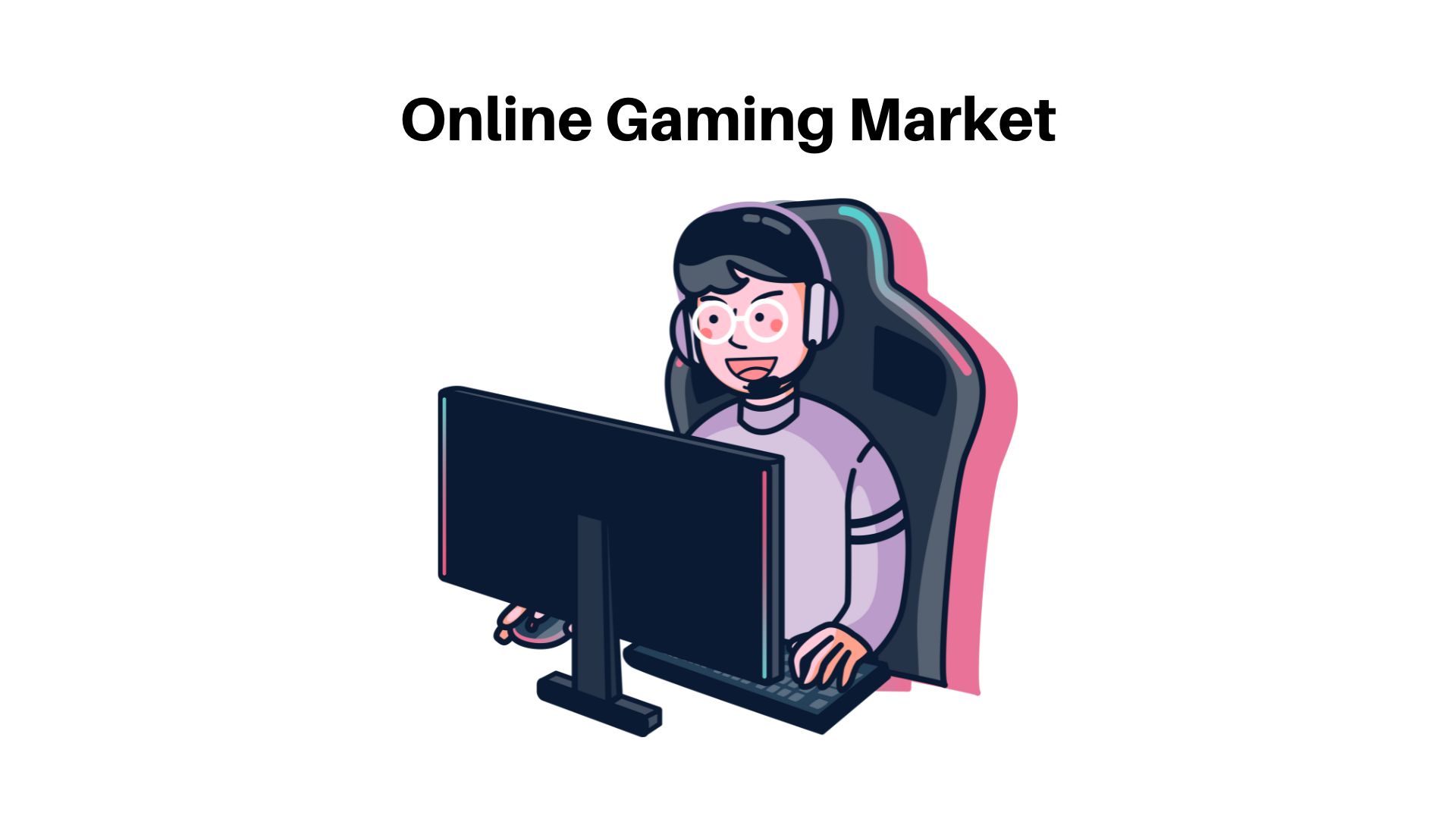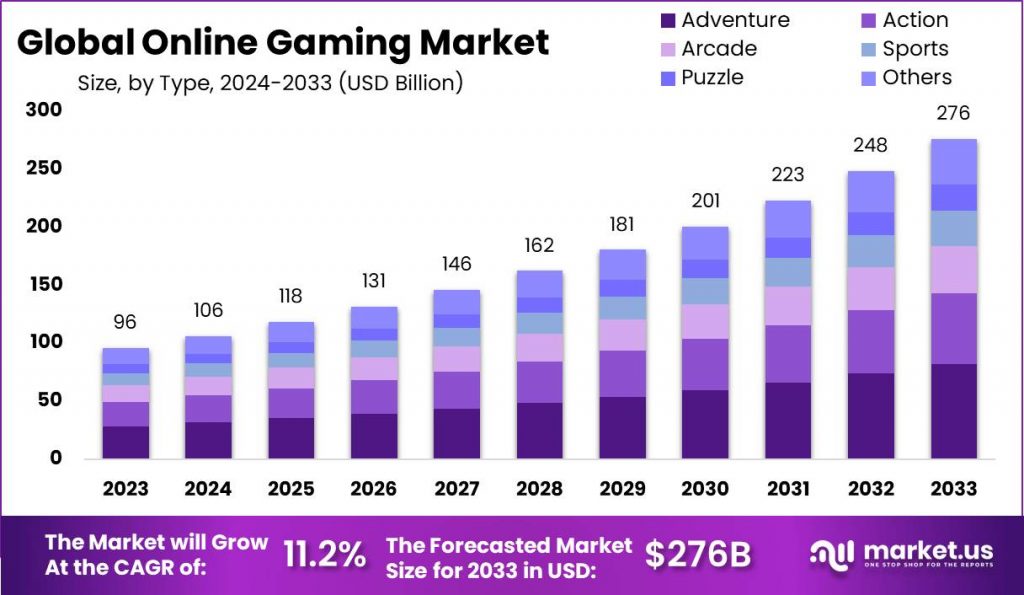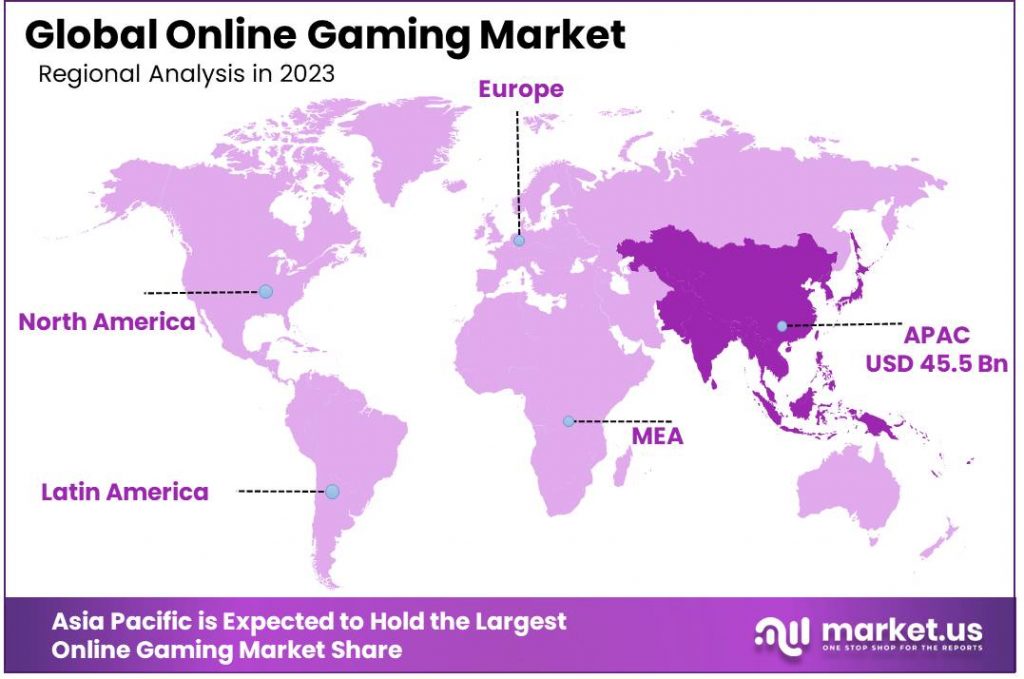Online Gaming Market Demand to Hit USD 276.0 Billion by 2033 | Globally at 11.2% CAGR

Page Contents
- Market Overview
- Key Takeaways
- Factors Affecting the Growth of Online Gaming Market
- Report Segmentation
- Type Analysis
- Platform Analysis
- Player Count Analysis
- Age Group Analysis
- Regional Snapshot
- Drivers
- Restraints
- Opportunities
- Challenges
- Key Market Segments
- Key Market Players
- Market Report Scope
- Recent Developments
- Frequently Asked Questions
Market Overview
Published Via 11Press: The Global Online Gaming Market size was projected to be USD 96 billion in 2023. By the end of 2024, the industry is likely to reach a valuation of USD 106.0 billion. During the forecast period, the global market for online gaming is expected to garner a 11.2% CAGR and reach a size of USD 276 billion by 2033.
Online gaming refers to playing video games through the internet, where multiple players can interact with each other in a virtual environment. This genre encompasses a wide range of game types, from simple puzzle games to complex simulations and massive multiplayer online games (MMOs). The core feature of online gaming is its ability to connect players from different locations, enabling real-time interaction and competition.
The online gaming market is a rapidly growing sector within the global entertainment industry, characterized by significant revenue generation and user engagement. The expansion of this market can be attributed to several factors, including the increasing availability of high-speed internet, the proliferation of smartphones and digital devices, and the rising popularity of esports and streaming services
Want to Access the Statistical Data and Graphs, Request PDF Sample @ https://market.us/report/online-gaming-market/request-sample/

Key Takeaways
- Market Growth: The demand of Online Gaming Market is expected to reach a staggering USD 276 billion by 2033, showing a steady Compound Annual Growth Rate (CAGR) of 11.2% from USD 96 billion in 2023.
- Dominance of Adventure Games: Adventure games held a dominant market position in 2023, capturing more than 30% share. This is attributed to story-driven games and advancements in gaming technology like AR and VR.
- Mobile Phone Dominance: In 2023, mobile phones dominated the market, capturing over 51% share due to widespread smartphone adoption and high-speed internet availability.
- Multiplayer Games on the Rise: Multiplayer and Massively Multiplayer Online (MMO) games were popular in 2023, capturing a substantial share. The social aspect and competitive gameplay contribute to their success.
- 25-34 Age Group Leads: The 25-34 years age group dominated the online gaming market in 2023, capturing more than a 32% share. This group has higher disposable income and a strong affinity for competitive gaming.
- APAC Market Dominance: In 2023, the Asia-Pacific (APAC) region emerged as the dominant force, capturing over 47.67% share. Countries like China, Japan, and South Korea have a deep-rooted gaming culture and widespread mobile gaming adoption.
- Key Players: Key players in the industry include Electronic Arts Inc., Activision Blizzard Inc., Sony Interactive Entertainment Inc., Tencent Holdings Ltd., and more. Tencent stands out as a dominant force, especially in the APAC region.
Factors Affecting the Growth of Online Gaming Market
- Technological Advancements: The rapid pace of technological innovation is a primary driver of growth in the online gaming market. Improvements in internet bandwidth, cloud computing, and digital payment systems enhance the gaming experience, making it more immersive and accessible. The development of high-quality graphics, augmented reality (AR), and virtual reality (VR) technologies further attracts a wider audience by offering more engaging gaming environments.
- Mobile Gaming Expansion: The proliferation of smartphones and tablets has significantly expanded the reach of online gaming, making it more accessible to a broad demographic. Mobile games offer the convenience of playing anywhere and anytime, contributing to the increased popularity and growth of the market. The ease of developing and distributing mobile games has also allowed a larger number of developers to enter the market.
- Social Gaming Trends: Online games that offer social interaction have become particularly popular, as they provide a platform for players to connect, compete, and collaborate. Social media integration allows players to share achievements and invite friends to play, further driving engagement and market growth.
- Esports and Live Streaming: The emergence of esports as a professional and spectator sport has had a significant impact on the online gaming market. Major tournaments and live streaming platforms such as Twitch and YouTube Gaming attract millions of viewers, generating substantial revenue through advertising, sponsorships, and merchandise sales.
Report Segmentation
Type Analysis
In 2023, the Adventure segment emerged as the dominant type in the online gaming market, capturing over 30% of the market share. This indicates that a significant portion of online gamers were actively engaged in adventure games.
The dominance of the Adventure segment can be attributed to several factors. Firstly, adventure games offer immersive and engaging narratives that appeal to a wide range of players. These games often involve exploration, puzzle-solving, and interactive storytelling, providing players with a sense of adventure and discovery. The captivating narratives and rich worlds created in adventure games can draw players in and keep them engaged for extended periods.
Additionally, adventure games often offer a diverse range of gameplay mechanics and experiences. They can incorporate elements of action, puzzle-solving, platforming, and role-playing, among others. This versatility allows adventure games to cater to different player preferences and provide a varied and engaging experience.
Furthermore, advancements in technology have allowed for more visually stunning and realistic adventure games. Improved graphics, sound design, and immersive technologies such as virtual reality (VR) have enhanced the overall experience of playing adventure games. Players can feel more connected to the game world, further amplifying their engagement and enjoyment.
Platform Analysis
In 2023, the Mobile phone segment emerged as the dominant platform in the online gaming market, capturing over 51% of the market share. This indicates that a majority of online gamers were engaging with gaming content through their mobile devices.
The dominance of the Mobile phone segment can be attributed to several factors. Firstly, the widespread availability and affordability of smartphones have made them accessible to a large population of gamers. Mobile phones have become an integral part of people's lives, providing convenient access to a wide range of entertainment options, including gaming.
Additionally, advancements in mobile technology have significantly improved the gaming capabilities of smartphones. Modern smartphones are equipped with powerful processors, high-resolution displays, and advanced graphics capabilities, allowing for immersive gaming experiences on the go. The availability of diverse gaming genres and a vast library of mobile games further contributes to the popularity of gaming on mobile devices.
Player Count Analysis
In 2023, the Multiplayer and Massively Multiplayer Online (MMO) segment emerged as a dominant force in the online gaming market, capturing a significant share. This indicates that a large number of players were actively engaged in multiplayer gaming experiences, whether it be through competitive multiplayer modes or immersive MMO environments.
The dominance of the Multiplayer and MMO segment can be attributed to several factors. Firstly, online multiplayer games offer players the opportunity to engage with friends, family, and other players from around the world. This social aspect of multiplayer gaming appeals to a wide range of players who seek to connect and interact with others while enjoying their gaming experience.
Additionally, the rise of esports has contributed to the popularity of multiplayer gaming. Competitive gaming has gained significant traction, with professional players and organized tournaments attracting a massive following. This has led to increased interest and participation in multiplayer games, as players strive to improve their skills and compete at higher levels.
Age Group Analysis
In 2023, the online gaming market saw the 25-34 years age group emerge as the dominant segment, accounting for over 32% of the market share. This age group's significant presence indicates that a substantial portion of online gamers falls within this demographic.
The 25-34 years age group's prominence in the online gaming market can be attributed to various factors. Firstly, individuals in this age range typically have a higher level of disposable income and are more likely to invest in gaming equipment, such as consoles, gaming PCs, and accessories. This financial capability allows them to explore a wide range of online gaming options.
Additionally, the 25-34 years age group often comprises individuals who have grown up with video games and have continued their interest in gaming into adulthood. Many of them have developed a strong affinity for gaming culture and may prioritize spending their leisure time playing online games.
Furthermore, this age group is commonly associated with the peak of their professional careers, which may provide them with greater flexibility in terms of time and resources to engage in online gaming. They may have more control over their schedules and can allocate time for gaming without significant restrictions.
Regional Snapshot
In 2023, APAC (Asia-Pacific) held a dominant market position in the Online Gaming market, capturing more than a 47.67% share. APAC's leading position can be attributed to several factors that contribute to the growth and adoption of online gaming in the region.
APAC has a large population with a significant number of active gamers, making it a lucrative market for online gaming. The region is home to several emerging economies and countries with a growing middle-class population, which has led to increased disposable income and a higher propensity to spend on entertainment, including online gaming.
Furthermore, APAC has witnessed rapid advancements in internet infrastructure, especially in countries like China, South Korea, and Japan. This has facilitated the widespread availability of high-speed internet connections, enabling seamless online gaming experiences. The proliferation of smartphones and affordable mobile data plans has also contributed to the popularity of mobile gaming in the region.
Cultural factors also play a role in APAC's dominance in the online gaming market. Gaming has become deeply ingrained in the culture of countries like South Korea and Japan, where esports and competitive gaming have gained significant traction. This has created a vibrant ecosystem of professional gamers, tournaments, and gaming enthusiasts, driving the growth of online gaming in the region.
Moreover, the increasing investments by gaming companies in APAC, along with strategic partnerships and collaborations, have fueled the market growth. These companies have focused on localizing their games, understanding the preferences of the APAC audience, and providing localized content and payment options.
The dominance of APAC in the Online Gaming market is expected to continue as the region's economies grow and the popularity of online gaming further increases. As internet penetration continues to expand, and with the advent of technologies like 5G, APAC is poised to remain a key player in the global online gaming industry.

Drivers
Technological Advancements
Technological advancements serve as a primary driver for the online gaming market, propelling its growth and evolution at an unprecedented pace. The integration of cutting-edge technologies such as virtual reality (VR), augmented reality (AR), and artificial intelligence (AI) has revolutionized the gaming experience, offering players immersive and interactive environments that were previously unimaginable.
High-definition graphics, faster processing speeds, and real-time streaming capabilities have significantly enhanced game quality and performance, attracting a wider audience. These innovations not only cater to the demands of a technologically savvy consumer base but also open new avenues for game developers to explore creative and complex game designs. Consequently, the continuous evolution of technology fosters a dynamic and competitive market environment, encouraging ongoing investment in research and development to deliver superior gaming experiences.
Restraints
Concerns over Cybersecurity
Cybersecurity concerns represent a significant restraint to the growth of the online gaming market. As online gaming platforms increasingly become targets for cyber-attacks, the risk to user data and privacy has escalated, leading to heightened apprehension among players and regulators alike. Issues such as identity theft, financial fraud, and data breaches can severely undermine user confidence and deter potential gamers from engaging with online platforms.
Moreover, the complexity and sophistication of cyber threats continue to evolve, challenging the industry to implement robust and effective security measures. This necessitates substantial investment in cybersecurity infrastructure and the development of advanced protective technologies, which can strain the resources of gaming companies, particularly smaller developers. The impact of cybersecurity concerns extends beyond individual users, affecting the reputation and financial stability of gaming platforms. Addressing these concerns is critical for maintaining a secure online environment, ensuring user trust, and fostering sustainable market growth.
Opportunities
Emergence of Cloud Gaming
The emergence of cloud gaming presents a transformative opportunity for the online gaming market, heralding a new era of accessibility and convenience. By leveraging cloud technology, games are hosted on remote servers, allowing users to stream them directly to their devices without the need for high-end hardware. This innovation significantly lowers the entry barrier for consumers, making premium gaming experiences accessible to a broader audience, including those with limited access to advanced gaming equipment. Cloud gaming's scalability and flexibility offer potential for unprecedented market expansion, reaching untapped demographics and geographical regions.
Furthermore, it facilitates instant updates and seamless cross-platform play, enhancing user engagement. As internet infrastructure continues to improve and cloud technologies become more sophisticated, the potential for cloud gaming to drive market growth is immense. However, the success of cloud gaming hinges on overcoming challenges such as latency issues and ensuring widespread high-speed internet access, which are crucial for delivering a high-quality gaming experience.
Challenges
Market Saturation
Market saturation poses a significant challenge to the online gaming industry. As the market becomes increasingly crowded with a plethora of games and gaming platforms, distinguishing new offerings becomes challenging. Gamers are faced with an overwhelming array of choices, making it difficult for new entrants to capture attention and gain traction. This saturation leads to intense competition among developers to innovate and differentiate their products, often necessitating substantial investment in marketing and development.
The pressure to stand out in a saturated market can also drive companies to adopt aggressive monetization strategies, potentially alienating users. For smaller developers, the barriers to entry are further heightened by the dominance of established players with significant resources. Overcoming market saturation requires strategic innovation, focusing on niche markets, or offering unique value propositions.
Interested in Procure The Data? Inquire here at: https://market.us/report/online-gaming-market/#inquiry
Key Market Segments
By Type
- Action
- Adventure
- Arcade
- Sports
- Others
- Puzzle
By Platform
- Mobile Phone
- PCs
- Consoles
- Others
By Player Count
- Single player
- Multi player
- MMO
- Others
By Age Group
- 18-24 YEARS
- 25-34 YEARS
- 35-44 YEARS
- 45-54 YEARS
- 55-64 YEARS
Key Market Players
- Electronic Arts Inc.
- Activision Blizzard, Inc.
- Sony Interactive Entertainment Inc.
- Rovio Entertainment Corporation
- Sega, Capcom Co., Ltd.
- Tencent Holdings Ltd.
- Apple Inc.
- Nintendo Co. Ltd.
- Microsoft Corporation
- Other key players
Market Report Scope
| Report Attribute | Details |
| The market size value in 2023 | USD 96 Bn |
| Revenue forecast by 2032 | USD 276 Bn |
| Growth Rate | CAGR Of 11.2% |
| Regions Covered | North America, Europe, Asia Pacific, Latin America, and Middle East & Africa, and the Rest of the World |
| Historical Years | 2018-2022 |
| Base Year | 2023 |
| Estimated Year | 2024 |
| Short-Term Projection Year | 2028 |
| Long-Term Projected Year | 2033 |
Recent Developments
1. Electronic Arts Inc. (EA):
- August 2023: Announced the acquisition of Glu Mobile, a mobile game developer known for titles like “Design Home” and “Disney Sorcerer's Arena,” for $2.1 billion, expanding their mobile gaming portfolio.
- October 2023: Launched “Apex Legends Mobile,” a free-to-play mobile version of their popular battle royale game, tapping into the booming mobile gaming market.
2. Activision Blizzard, Inc.:
- January 2023: Announced a partnership with Microsoft for their $68.7 billion acquisition, aiming to create a leading interactive entertainment company with significant online gaming presence.
- June 2023: Launched “Call of Duty: Modern Warfare 2,” a highly anticipated sequel to the popular Modern Warfare series, attracting millions of online players at launch.
3. Sony Interactive Entertainment Inc. (SIE):
- March 2023: Acquired Haven Studios, a new game development studio led by industry veterans known for the Uncharted series, boosting their first-party online game development capabilities.
- July 2023: Launched “PlayStation Plus revamp,” offering tiered subscription plans with access to a wider library of online games and additional benefits,
Frequently Asked Questions
Q. 1: What are some of the major players in the online gaming market?
A: Some of the leading players in the online gaming market include Electronic Arts Inc., Activision Blizzard Inc., Sony Interactive Entertainment Inc., Rovio Entertainment Corporation, Sega, Capcom Co. Ltd., Tencent Holdings Ltd., Apple Inc., Nintendo Co. Ltd., Microsoft Corporation, Other key players
Q.2: What are some of the key applications of online gaming?
A: online gaming can be used in various applications, including Young Adults, Adults, Mature Adults, Seniors
Q.3: What is the size of the online gaming market?
A: Global online gaming market size was valued at USD 61.7 Billion in 2022. Also will achieve a market size of USD 163.0 Billion by 2032, budding at a CAGR of 10.2%.
Q.4: What are the primary drivers fueling the growth of the online gaming industry?
Growth in the online gaming industry is driven by factors such as increasing internet penetration, the rise of mobile gaming, advancements in virtual and augmented reality, and the popularity of esports.
The team behind market.us, marketresearch.biz, market.biz and more. Our purpose is to keep our customers ahead of the game with regard to the markets. They may fluctuate up or down, but we will help you to stay ahead of the curve in these market fluctuations. Our consistent growth and ability to deliver in-depth analyses and market insight has engaged genuine market players. They have faith in us to offer the data and information they require to make balanced and decisive marketing decisions.



